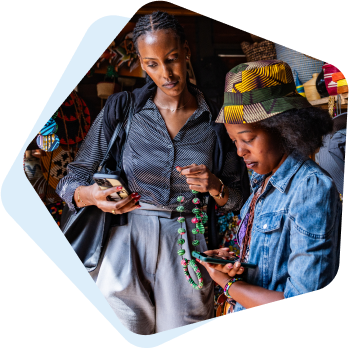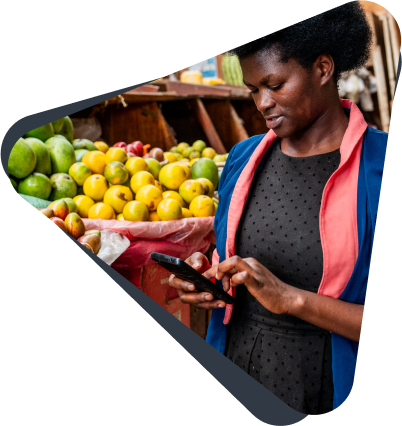How to Implement
Guidance

Enable DFSPs to rely on access points to affordably deliver financial services.
Relevant authorities should support, as needed, the ability for DFSPs to provide a range of financial services in traditional and non-traditional points of service or access points. Regulation defines the requirements for types of individuals or entities that can be an access point. DFSPs should be able to enter into agreements with third parties to provide services on their behalf (e.g., agent or kiosk banking) via commercially reasonable arrangements that extend the DFSP and Scheme value proposition without unnecessarily adding risk or cost.

Understand agent payment needs.
Agents commonly are the primary point of interaction for low-income end users. They typically serve multiple payment systems and the Scheme should ensure that their needs are understood. Agent environments can also vary widely in terms of electricity, internet, tools, and integration software with the DFSP they are serving.

Design for agent payment needs.
After cataloging the varied needs of agents as acceptors and originators of payments, ensure that Scheme technical requirements and rules support seamless payments to and from all types of end users.

Increase the number of women agents.
The Scheme works with DFSPs and the regulator(s) to increase the number of women agents, guided by regulatory goals or setting their own targets to ensure that a minimum number of women agents are available to support women and men end users.

Support familiar and proximate representatives.
DFSP branch staff and agents represent known, trusted, and well-trained entities in the eyes of women customers. This may mean hailing from the same community as the women customers or place local agents at nationally known and trusted access points (such as shops). Training of access points should include gender sensitization for men agents to empower them to better serve women.
Why It Matters
Widespread access points ensure users can easily transact and carry out other needed financial services, making the Inclusive IPS more useful.
Seeing More Clearly
Select a lens to learn the “why” this practice.
Women’s Inclusion
Many women end-users prefer to conduct digital payments in-person with proximate and familiar agents – and often with other women agents – to set up accounts and resolve payment issues. In person support from a trusted agent builds capability and confidence.

Tools
Design Guides
Dig into how to implement each of the practices.
Integrating Learning Moments
Recommendations for types of information that could be included in embedded learning moments, alongside illustrative market examples.
Review Integrating Learning MomentsAn Imperative for End-User Co-Design
Summary of existing resources related to embedding users into the design process for digital public infrastructure generally and Inclusive IPSs specifically.
Review An Imperative for End-User Co-DesignEmbedding Personal Safety Features into User Interface
Resources for ensuring that women have adequate safety protections within a DFSP user interface.
Review Embedding Personal Safety Features into User InterfaceUser Interface Attributes
Overview of key user interface attributes and illustrative market examples.
Review User Interface AttributesSelect Resources for Policymakers in Driving Increased Women Agent Networks
Description of existing guidance on increasing the number of women agents and a call to action for enabling financing to help women become agents.
Review Select Resources for Policymakers in Driving Increased Women Agent NetworksSafeguarding Against Intimate Partner Violence
This risk note describes the unintended consequence of intimate partner violence, which may arise as a byproduct of directing payments to women, and offers strategies…
Review Safeguarding Against Intimate Partner ViolenceDigital G2P Payments Made Directly to Women-Owned Accounts
This design note summarizes and links to three excellent reports illustrating the particular benefits of directly G2P payments to women recipients, and suggesting practical guidance…
Review Digital G2P Payments Made Directly to Women-Owned AccountsGeneric payments scheme rulebook categories and example table of contents
A generic scheme rules that IIPS operators can use to build their own rulebook
Review Generic payments scheme rulebook categories and example table of contentsMarket Illustrations
Learn from design choices in action.
Global Approaches to Alias Addressing
Country
Multiple
Challenge
Not all users are comfortable with or have access to any given alias type, and women are more likely to encounter limitations because of privacy concerns and technology access.
Outcome
As a result of Inclusive IPS supporting multiple alias options, end users can use the alias they feel most comfortable with.
Gatekeeper Engagement from TEB Bank Turkey and Jazz Cash Pakistan
Country
Turkey, Pakistan
Challenge
DFSPs in each country recognized the impact of gatekeepers on women’s financial inclusion.
Outcome
Through targeted engagement campaigns, providers have challenged traditional gender norms related to financial inclusion.
Representative Communications Example from Pakistan
Country
Pakistan
Challenge
In Pakistan, women’s adoption of digital financial services lags men’s, with only about 10–15% of JazzCash users being women.
Outcome
Targeted SMS campaigns led to a 34% increase in account opening referrals, particularly by women.
Financial Capability Initiative Led by IPS: Jordan’s JoPACC
Country
Jordan
Challenge
Despite advancements in Jordan’s digital payment payments, financial inclusion remains a challenge, particularly among smallholder farmers and rural vendors.
Outcome
A targeted intervention campaign at the National Olive Festival led to higher digital payment usage, supporting financial inclusion goals.
Digitalizing Female Garment Worker Salary Payments in Bangladesh with HerProject
Country
Bangladesh
Challenge
In Bangladesh, female garment workers faced major barriers to digital financial inclusion, including low digital literacy, restrictive social norms, and limited access to mobile financial services and mobile phone devices.
Outcome
As a result of digital literacy training and social norms interventions, many women began actively using their accounts for savings and transactions beyond wage receipt, indicating stronger engagement with formal financial services.
Building Financial Capability in G2P Payments in Zambia
Country
Zambia
Challenge
Women in Zambia’s poorest communities faced limited financial literacy, low participation in formal financial systems, and barriers to accessing and using financial products, which constrained their ability to save, invest, and manage payments effectively.
Outcome
100% of Zambia Girls’ Education and Women’s Empowerment Livelihoods Project participants use digital payments to receive their GEWEL benefits.
Rethinking the POS through Audio Notifications To Make User Interfaces More Inclusive
Country
India
Challenge
Consumers and merchants require a confirmation to ensure that a merchant transaction has been completed successfully, and must both be aware of this notification simultaneously in order for it to be effective.
Pix Scheme Rules Set Minimum Requirements for Notifications
Country
Brazil
Challenge
Users may experience transaction failures or delays for a variety of reasons.
Outcome
Through Pix’s required notifications, users clearly understand why something has gone wrong and what might happen as a result.
Pix Randomized Key Alias
Country
Brazil
Challenge
In designing Pix, the Brazilian central bank recognized the need to offer a variety of alias options
Outcome
The randomized key is the most used alias, with the key representing 49% of total registered aliases
Certainty of Payee in UPI (India)
Country
India
Challenge
Users must have a way to ensure that they are sending funds to the correct recipient.
Outcome
UPI offers a clear, consistent way to ensure that funds are sent to the correct recipient.
Certainty of Payee Flow in Pix (Brazil)
Country
Brazil
Challenge
Users must have a way to ensure that they are sending funds to the correct recipient.
Outcome
Pix offers a clear, consistent way to ensure that funds are sent to the correct recipient.
Complaint and Funds Refund Mechanism in Brazil
Country
Brazil
Challenge
Pix recognized that some potential and existing users of the IPS were concerned about using the system for fear of experiencing fraud and loss of funds.
Outcome
Pix’s Special Mechanism for Return is used extensively, although recovery of funds tends to be limited. Further improvements are planned.
Related Resources
From the Community
Helpful resources from other organizations on implementing this practice.
Explore more practices
Review other L1P practices and learn more about how to apply them to your IPS.

